
Among the three travertine quarries owned by Fratelli Poggi, a company that began quarrying Roman travertine in Tivoli, Italy, in 1923, is a site that was opened in 1963. Currently, the quarry is about 50 meters deep, and it is estimated that it will be fruitful for another 12 to 15 years.
As a leading supplier of Italian travertine, Fratelli Poggi runs an impressive operation at its base in Tivoli, Italy. The company, which has been in business since 1923 and is now under a third-generation ownership, owns and operates three quarries. And to further secure its place in the global market, it recently opened Poggi Brothers, Inc. USA in Tampa, FL, which is already showing encouraging signs of growth.
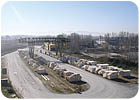
With a total of 70 employees in its quarries, fabrication facility and office in Italy, the company has established itself as a leading supplier of travertine for the worldwide market.
Presently, the primary markets for the U.S. office are Florida and Georgia, and a total of 50% of its sales is travertine. In addition to its own material, Poggi Brothers, Inc. USA is importing travertine from regions such as Mexico and Peru.
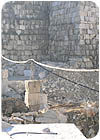
At the quarry, blocks are split with drills.
Quarrying in Tivoli
And because travertine comprises half of the company's business in the U.S., Fratelli Poggi is diligently working to meet market demand. One of the company's premium materials is Roman Classic travertine, which is used extensively in the U.S., according to Mauro Poggi, adding that one prominent project is the Ronald Reagan Federal Reserve Building.Among Fratelli Poggi's travertine quarries is one that was opened in 1963. This quarry, which is currently about 50 meters deep, has about 12 to 15 years worth of material left, according to the company. Additionally, the original quarry that was purchased by Fratelli Poggi in 1923 was reopened three years ago, and it is about 40 meters deep.
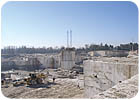
Three years ago, Fratelli Poggi reopened the original quarry that was purchased in 1923.
To tilt the bank, a deep hole is first drilled with high-pressured hydraulic jacks. A steel wire with diamond studs is then inserted in the hole to cut the bank, which can weigh as much as 1,000 metric tons. The cutting is performed with a Fantini chainsaw.
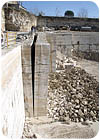
At the time of Stone World's visit, quarry workers were taking down a bench at the original site. To tilt the bank, a deep hole is first drilled with high-pressured hydraulic jacks.
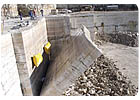
A steel wire with diamond studs is then inserted in the hole to cut the bank, which can weigh as much as 1,000 metric tons. The cutting is performed with a Fantini chainsaw.
In addition to its quarries, Fratelli Poggi runs a saw mill for cutting blocks as well as a full-scale fabrication facility. In total, it employs approximately 70 workers in Italy. Additionally, Poggi Brothers, Inc. USA currently has 12 workers. “It is growing by the minute,†said Colledani, about the U.S. operation.


